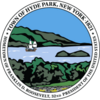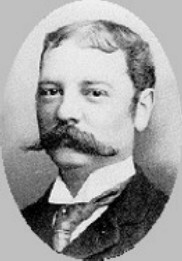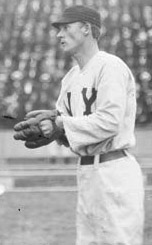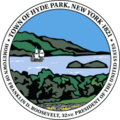Hyde Park, New York facts for kids
Quick facts for kids
Hyde Park, New York
|
||
|---|---|---|
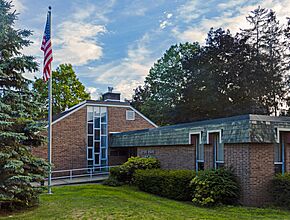
Town hall of Hyde Park
|
||
|
||
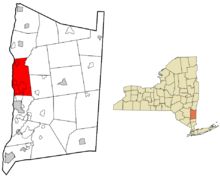
Location within Dutchess County and the state of New York
|
||
| Country | United States | |
| State | New York | |
| County | Dutchess | |
| Named for | Edward Hyde, 3rd Earl of Clarendon | |
| Government | ||
| • Type | Town council | |
| Area | ||
| • Total | 39.86 sq mi (103.23 km2) | |
| • Land | 36.66 sq mi (94.95 km2) | |
| • Water | 3.19 sq mi (8.28 km2) | |
| Elevation | 249 ft (76 m) | |
| Population
(2020)
|
||
| • Total | 21,021 | |
| Time zone | UTC−5 (Eastern (EST)) | |
| • Summer (DST) | UTC−4 (EDT) | |
| ZIP code |
12538
|
|
| Area code | 845 | |
| FIPS code | 36-027-37209 | |
| GNIS feature ID | 0979090 | |
Hyde Park is a town in Dutchess County, New York, United States. It is located along the Hudson River, just north of Poughkeepsie. Inside the town, you'll find smaller communities called hamlets, such as Hyde Park, East Park, Staatsburg, and Haviland. Hyde Park is famous for being the hometown of Franklin D. Roosevelt, who was the 32nd president of the United States.
This town is also home to the main campus of the Culinary Institute of America. This is a special four-year college where students learn to become chefs and bakers. You can also visit the Franklin D. Roosevelt Presidential Library and Museum here. It was the very first presidential library ever built in the United States.
In 2020, about 21,021 people lived in Hyde Park. A major road, U.S. Route 9, runs through the town close to the Hudson River.
Exploring Hyde Park's Past
People from Europe first started settling in this area around 1742. Some believe it might have happened even earlier, around 1710.
The town's name changed to "Hyde Park" around 1810. Before that, it was known as "Stoutenburgh." This name came from Jacobus Stoughtenburg, who was the first settler in the area. Part of the town's land came from a very old land grant called the Great Nine Partners Patent from 1697.
How Hyde Park Got Its Name
A doctor named John Bard owned a large estate here. He called his estate "Hyde Park" to honor Edward Hyde, 3rd Earl of Clarendon. Edward Hyde was a governor of New York from 1702 to 1708. In 1697, he gave a big piece of land "south of Albany" to nine of his friends. This land became a large part of what is now Hyde Park.
Later, around 1804, a tavern owner named Miller wanted to attract more visitors. He renamed his tavern "the Hyde Park Inn." Doctor Bard wasn't very happy about this. Miller then asked for a post office to be placed at his inn, which was a common thing for tavern owners to do. His request was approved, and it became the "Hyde Park Post Office." Slowly, the area became known as Hyde Park instead of Stoutenburgh. It officially became the town of Hyde Park in 1812.
Hyde Park used to be part of another town called Clinton, New York. But in 1821, it became its own separate town. The Hyde Park Railroad Station was important for the town's residents, including the Roosevelt family.
The town is also home to the beautiful mansion of Frederick William Vanderbilt. This mansion is now a national historic site called the Vanderbilt Mansion National Historic Site.
The Famous Roosevelt Family
Hyde Park is the special hometown of Franklin D. Roosevelt (1882–1945). He was the president of the United States from 1933 until he passed away in 1945. His family home, called Springwood, is now a museum. The National Park Service takes care of it. His presidential library and museum are also located there. Roosevelt lived in this house throughout his life. You can visit his historic home today.
Many important homes in Hyde Park are listed on the U.S. National Register of Historic Places. These include the homes of Eleanor Roosevelt, Isaac Roosevelt, and Frederick William Vanderbilt. Even Haviland Middle School, which used to be Franklin D. Roosevelt High School, is on this list.
Val-Kill was the home of Eleanor Roosevelt, who was Franklin D. Roosevelt's wife. It is about 2 miles (3.2 km) east of FDR's home.
Both Franklin D. Roosevelt and Eleanor Roosevelt are buried in the rose garden at "Springwood."
President Roosevelt's father, James Roosevelt, Sr., also served as the town supervisor for Hyde Park for a time.
Where is Hyde Park Located?
The United States Census Bureau says that the town of Hyde Park covers a total area of about 39.86 square miles (103.2 km2). Out of this, 36.66 square miles (95.0 km2) is land, and 3.19 square miles (8.3 km2) is water. The water makes up about 8.02% of the total area.
The Hudson River forms the western border of the town. This river also separates Hyde Park from Ulster County. Hyde Park shares its southern border with the town of Poughkeepsie. To the north, it borders Rhinebeck. To the east, you'll find the towns of Clinton and Pleasant Valley.
Who Lives in Hyde Park?
In 2010, the town's population was 21,571 people. Most residents, about 87.1%, were white. About 6.0% were African American, and 2.5% were Asian. People of Hispanic or Latino background made up 5.6% of the population.
Back in 2000, there were 20,851 people living in Hyde Park. There were 7,395 households, and 5,220 families. About 34.0% of households had children under 18 living with them. The average household had 2.63 people.
The median age of people in the town was 36 years old. This means half the people were younger than 36, and half were older.
| Hyde Park | ||||||||||||||||||||
|---|---|---|---|---|---|---|---|---|---|---|---|---|---|---|---|---|---|---|---|---|
| Population growth since 1830 | ||||||||||||||||||||
| Year | 1830 | 1840 | 1850 | 1860 | 1870 | 1880 | 1890 | 1900 | 1910 | 1920 | 1930 | 1940 | 1950 | 1960 | 1970 | 1980 | 1990 | 2000 | 2010 | 2020 |
| Population | 2,554 | 2,364 | 2,425 | 2,749 | 2,695 | 2,873 | 2,821 | 2,806 | 3,019 | 2,880 | 3,388 | 4,056 | 6,136 | 12,681 | 16,910 | 20,768 | 21,230 | 20,851 | 21,571 | 21,021 |
| U.S. Decennial Census | ||||||||||||||||||||
Communities and Interesting Places in Hyde Park
Local Communities
- East Park—a small community located to the east of the main Hyde Park village.
- Haviland—a community found in the southern part of the town.
- Hyde Park—this is the main hamlet of Hyde Park, located near the Hudson River on Route 9.
- Staatsburg—a community by the Hudson River in the northwestern part of the town.
Places to Visit
National Parks and Sites
- Eleanor Roosevelt National Historic Site
- Franklin D. Roosevelt Presidential Library and Museum
- Home of Franklin D. Roosevelt National Historic Site
- Top Cottage
- Vanderbilt Mansion National Historic Site
State Parks
- Ogden Mills & Ruth Livingston Mills State Park
- Margaret Lewis Norrie State Park
Historic Places on the National Register
- Crum Elbow Meeting House and Cemetery
- Bergh–Stoutenburgh House
- Franklin Delano Roosevelt Junior-Senior High School (now Haviland Middle School)
- Hyde Park Elementary School
- Hyde Park Firehouse (now Hyde Park Historical Society Museum)
- Hyde Park Post Office
- Hyde Park Railroad Station
- John Hendricks House and Dutch Barn
- Main Street-Albertson Street-Park Place Historic District
- Quaker Lane Farms
- Hyde Park Reformed Dutch Church
- Roosevelt Point Cottage and Boathouse
- St. James Chapel
- Vanderbilt Lane Historic District
- Wales House
- William Stoutenburgh House
Schools in Hyde Park
Most of the town, including the Hyde Park hamlet, is part of the Hyde Park Central School District. A small part of the town in the southeast belongs to the Arlington Central School District. A small area to the north is in the Rhinebeck Central School District.
The main high school for the Hyde Park school district is Franklin Delano Roosevelt High School.
Famous People from Hyde Park
Actors
- Joseph Mazzello: An actor known for movies like Jurassic Park and Bohemian Rhapsody.
Artists
- Angela Fraleigh: A modern artist known for her oil paintings.
- Alice Provensen: An artist and illustrator of children's books.
- Martin Provensen: A children's book illustrator and the designer of Tony the Tiger, the Kellogg's mascot.
Business Leaders
- André Balazs: A person who owns hotels and restaurants.
- Frederick William Vanderbilt: A successful businessman, helper of charities, and railroad leader.
- James Roosevelt I: A businessman and the father of President Franklin D. Roosevelt.
- John Aspinwall Roosevelt: A businessman and US Navy Officer who received the Bronze Star Medal. He was also the son of President Franklin D. Roosevelt.
- Ogden Mills: A financier and horse racing owner.
Journalism
- Lorena Hickok: A well-known journalist.
Musicians
- Rudolf Firkušný: A classical pianist born in the Czech Republic.
- Jeff Tyzik: A conductor, arranger, and trumpeter.
Scientists and Doctors
- Samuel Bard: A doctor who was personal physician to George Washington. He also started the first medical school in New York State.
- David Hosack: A famous doctor, botanist, and educator.
Sports Stars
- Amar'e Stoudemire: A former professional basketball player who played in the NBA for teams like the Phoenix Suns and New York Knicks.
- George Browne: A professional baseball player from 1901 to 1912. He was part of the 1905 World Series Champion New York Giants.
- Ricky Horton: A former professional baseball pitcher who played for the St. Louis Cardinals.
- Ellen Roosevelt: A three-time U.S. National Championship tennis player and a member of the International Tennis Hall of Fame.
Writers
- Joan Slonczewski: A microbiologist and science fiction writer.
- Justin Taylan: An author and World War II historian.
Images for kids
See also
 In Spanish: Hyde Park (Nueva York) para niños
In Spanish: Hyde Park (Nueva York) para niños


